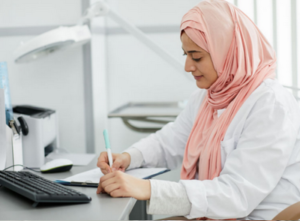This article reviews FAQs: GMP e-Learning Development questions and answers. We’ll also explore comparisons between Webinars vs E-learning courses — and comparisons to Podcasts — as alternatives to classroom-based delivery methods.
Alternatives to classroom-based GMP courses
Online Training Development and eLearning Design Basics
Education technologies, digital delivery requirements and e-learning hosting costs: FAQs and e-Learning development questions answered by our online learning experts
Long before COVID-19 meant digital training was the only viable option for some periods of time (and became the ‘go to’ GMP training delivery method, versus an optional method), digital courses (GMP eLearning training) have had increasing adoption rates.
In addition to regulatory compliance training (GMP eLearning courses), online learning options have been popular in a variety of education settings. These include but are not limited to:
- organisational induction training programs
- educational settings including K-12
- private training providers
- top-ranked Universities across the globe
- healthcare providers and pharmaceutical manufacturing organisations
Nearly all modern Universities, registered training organisations (RTOs) and industry-led training providers — including PharmOut (a leading GMP Consultants firm) — were already using some form of online training with their personnel. E-learning was an increasingly popular training option long before it became the most practical training delivery method during periods of quarantine or travel bans. Additionally, e-Learning is particularly helpful for meeting individual training needs and GMP course completion timeframes.
Popular online training courses in regulatory compliance, clinical research and public health:
- Medical supply manufacturing regulations
- Online GMP training (certificate GMP courses based on PICS/GMP guidance including Annexes 1-20)
- EUGMP training and medicinal cannabis cultivation (regulations compliance)
- Medical device regulatory compliance training
- Good Laboratory Practice (GLP) eLearning (GLP training course)
- Good Recordkeeping Practice training for GMP personnel (Good Documentation Practice)
Blended-training methods should always include online training alternatives, and GMP eLearning is a viable, effective and inexpensive training option for all levels of personnel who need GMP compliance training.
In the days of the pandemic, online courses became the best option for delivering ‘just in time’ education, including GMP compliance education.
- Online GMP courses/GMP e-Learning courses are a convenient, cost-effective way to train your teams and contractors in:
- GMP compliance and/or EU cGMP requirements
- Other regulatory compliance requirements; including Quality Management Systems and Quality Risk Management courses
There are also specific eLearning courses for different therapeutic goods industries, including Medical Devices regulations, Medicinal Cannabis Cultivation regulations, and more.
Blended-learning experiences help increase compliance with regulations, because:
- Regulatory Compliance & GMP eLearning courses increase data retention
- They offer self-paced learning experiences (24/7) from any internet-connected location (using a laptop orPC), and
- They are great alternatives to classroom training and onsite delivery modalities.
Durig the pandemic, medical supply chains were stretched to their limits (and beyond). GMP compliance training had to continue, of course — medicine and PPE production were crucial to help prevent more deaths. So compliance training went online. GMP compliance training and medical device quality management training courses were transferred to Zoom-based delivery options and eLearning courses.
Why? Because ensuring compliance with regulations was never more important than when in the path of a rapidly-spreading pandemic…where gaps in GMP, biologicals GxP (including good laboratory practice and good recordkeeping practice) could lead to an increased risk for spreading the disease. And where supply shortages could lead to serious public health harms.
GMP training is crucial, for example, in medical device manufacturing (COVID-19 test kits); pharmaceutical manufacturing (biologicals, vaccinations, anti-virals), and veterinary medicines.
GMP eLearning courses provide 24/7 convenience for compliance training; PLUS budget-comfort. And they are complete with online assessments for gaining a Certificate of Completion (meeting GMP recordkeeping requirements for training).
But the primary value of GMP eLearning courses is their value in increasing GMP compliance.
This includes increasing GMP compliance amongst long-term personnel, temporary contractors, periodic maintenance workers, cleaners and supply-chain vendors.
With audit findings on the rise in the USA per the latest statistics from FDA inspections, organisations need GMP training more than ever before. They need it to be affordable…and with COVID19 spreading, they need it now.
Updates on E-learning development, applications and related technologies are especially relevant in the current climate.

Example of a new course in Pharmaceutical Manufacturing Fundamentals (Pharmaceutical Water Systems/Water Quality).
Be sure you also visit the updated PICS Annex 2B – GMP-based Biologicals manufacturing course if you’re working with these medicines. (Annex 2 was split into 2 different Annexes with the release of PE 009-14; our Annex 2 courses (2A and 2B) cover the updated PIC/S guidance.
Education courses and online delivery options in response to coronavirus (COVID-19).
Health-protection initiatives are expected to have a significant impact on education delivery methods and education-based economies in the coming months.
Virus-related lifestyle changes meant e-learning alternatives, compared to classroom training options, increased exponentially in value.
Like other training, GMP e-learning still works best when blended with face-to-face instruction. It does not replace on-the-job, site-specific training and Supervision. Yet when the pandemic impacted the ability to offer in-person small or large group training courses (face-to-face), online training, and virtual training (via Zoom) became the ‘go to education delivery method’ .
How did Universities and pharmaceutical manufacturers adapt?
Initially, a lot of Universities just ‘paused’. They eventually adapted their delivery methods from classroom-style lectures to video training and online (eLearning) courses.
Pharmaceutical & medical device manufacturers didn’t have time to pause. Their products were in very high demand. So they relied heavily on online training options as part of their training programs as well as Zoom-delivered courses (facilitated by a GMP expert consultant). (Within days after I originally posted this article, most Universities had shut down and were transitioning to fully-digital training delivery programs.)
Customised GMP consultancy and training remain in high demand.
Fortunately, GMP e-Learning courses are already available and affordable.
GMP eLearning courses suit most training budgets.
E-learning helps organisations meet their annual training and development budgets.
But perhaps more importantly in today’s climate, e-learning offers instant training access for new pharmaceutical employees or manufacturing contractors and suppliers.
- Courses range from GMP training to employee orientation for a variety of manufacturing industries.
- They can cover topic introductions (warm-ups ) or be used for in-depth qualification courses.
- Simple delivery formats enable inexpensive e-Learning course formats
- Costs of e-learning modules to end-users can be lowered by capping e-learning development costs and using simpler formats

e-Learning module development costs (averages)
Developing an e-learning course series can range in cost, from ~ $8,000 for a short course module to upwards of $20,000 USD for a series of courses. Often, developing online training resources cost companies from $50,000 to $100,000 or more. It depends on how sophisticated you make the training and the complexity of the training topic.
When everything was changing fast during the pandemic, companies needed to keep costs reasonable while making content-rich training (but with delivery formats that could be quickly updatable when something changed). Updates to e-Learning courses are referred to as ‘content updates’, or ‘time-sensitive revisions’; keep in mind these can change your development costs and e-Learning training development budget.
Note: There are significantly varying estimates for e-Learning course development costs. There is no single ‘estimated price’ as courses vary in topic, topic depth coverage, interactivity, accessibility, online assessments, and more.
Average costs for eLearning development (online education resources/design costs) will vary greatly as few courses will be completely identical.
What factors impact E-learning Development Costs?
- how complex the material is
- which technologies and apps you are using for your e-learning course development
- software/apps and management/administration costs of Learning Management Systems (LMS)
- technological upgrades
- access to an SME and their accuracy in terms of current and relevant data
- how often the courses need to be updated/maintained by a professional with appropriate skills and knowledge
Essentially, to estimate your development costs, factor in your employee time (instructional designers), subject matter experts time (SMEs), delivery software costs and LMS hosting fees including administration, training updates and software licencing.
Some e-learning series can cost far greater to develop and host; even so, they offer a very scalable way to train numerous employees without the need to pay for a venue while also reducing personnel travelling times, costs and risks.
Summary: Online courses are excellent for delivering education from remote locations.
PharmOut’s GMP eLearning courses have been designed specifically to be an effective and affordable certificate GMP training option. These courses provide a useful option for training employees and contractors, for initial induction training and refresher training, or to help someone improve their GMP knowleldge when they are changing job roles or getting promoted.
E-learning offers trainers and learners three key advantages over classroom training.
These key advantages of e-Learning are flexibility, convenience and client-centric pacing.
Online courses are also a cost-effective measure for designated training budgets. This includes topics like GMP, GDP and Good Record-Keeping practice (GRK) for regulatory compliance.
Click here for alternatives to classroom-based training.
Definitions and e-Learning terminology
Definition of e-Learning/Online Courses:
An e-learning course (online training module) is one of several different types of digital training formats.
- E-learning modules are essentially training courses which are delivered over the internet, typically in ‘brief chunks of time.’
- Online courses are typically accessible on a 24/7 basis for most learners.
- Internet access is required.
- Courses will also use a certain amount of data download capacity (part of typical data plans).
Online courses provide instant training access for learners and certificates of completion (e.g. a GMP Certificate Course). They also offer users the chance to review the content, over a designated time frame.
A training module is simply another name for an e-learning segment.
Training modules (units) may cover a specific topic, as part of a broader digital training initiative.
- E-Learning Courses are first thoroughly researched and designed to meet audience needs (learning objectives).
- These modules are pre-recorded/pre-developed training modules.
- They are typically not dependent on a presenter for delivery (which is very different to webinars or podcasts which rely heavily on the talents and knowledge of the key presenter(s).
- So while online courses can be costly to develop, e-learning may have an extensive shelf-life to make their development more cost-effective.
E-learning currency depends on how fast an industry changes.
- High-cost e-learning development is not advised for rapidly changing industries.
- The exception is high-learner volume topics, where a subject matter expert (SME) is on hand for frequent updates.
Online training courses employ e-learning delivery formats. They promote concepts of entirely self-paced training so are inherently learner-centric (end-user focused).
- Accessing an e-learning module requires the learner to attain a username and password, via online registration formats.
- Most modern e-Learning modules will have built-in interactivity to increase engagement and knowledge retention; contrasted to the passive nature of watching video-only formats and passive listening formats for audio recordings.
FAQs e-Learning development

e-Learning development Questions and Answers including delivery formats, software, digital course delivery requirements and hosting costs.
How are online courses created, hosted and distributed?
The basic process of e-learning course development (online training) involves:
Planning and Content Organisation
- A training gap/course topic is identified
- Research is performed to identify the gap
- The content is assessed as being suitable for online course development (if not, it might be purely classroom-based)
- Existing content should be assessed to determine the next step, e.g.
- (a) Use existing content via paying for a licence
- (b) Create new content that gives you proprietary ownership (beware copyright infringements re legal charges, steep fines and penalties)
For option (b) as covered in this article:
- Course content is curated and arranged (this is a key component of instructional design)
- Subject matter experts (SMEs) often participate in the design (or review the final drafts)
- The implementation stage of designing the e-learning course then begins – this is the hands-on e-learning development phase
Implementation into appropriate software/apps and learning management systems (LMS)
- The course is broken down to data themes — using a process called ‘storyboarding’ or scene-setting
- The course is then designed (instructional design) to fit into an available training app (software/platform)
- The materials and resources are carefully compiled into the selected program
- Interactivity (and/or gaming-style engagement) is added to improve learner experiences and content engagement
- The course unit(s) are then uploaded to the Learning Management System (LMS)
Online courses will generally comprise multi-media delivery methods (images, text, words, graphics, videos and interactivity).
The greater the interactivty, the higher the likely engagement — and the more enjoyable the course. This interactivity is one of the key factors differentiating online training from lecture-based presentations and traditional webinars or podcasts.

e-learning development: Inclusions and exclusions
Typical inclusions for online courses include:
- Definitions of common terminology relating to the training topic
- Curated content is divided into:
- 3o to 90-minute self-contained modules
- Graduated/sequenced according to complexity (using principles of education content organisation)
- Text media in plain language
- Narrated text
- Graphics (photographs or illustrations, graphs, pie charts, etc)
- Bullet-points (highlights)
- Legal or Industry References
- Video clips
- Quizzes and Assessments
- Certificate of Completion after passing an assessment
Some online courses enable adaptations to suit users with varying abilities; such as using larger fonts or adjustable audio tracks.
Online courses may also suit individuals with limited physical mobility because they can be completed from the comfort of a home (or hospital bed) — as long as the person can use the required technology to access the course.
However, most online courses — by their nature — rely on providing visual cues along with text, graphs and auditory information and hence, may not suit all users.
Exclusions for e-learning courses tend to relate to the practical, hands-on aspects of training courses.
Whether or not your e-learning has an option for personal support (educational contacts) or practical sessions is another option you can provide to learners
- It’s important to recognise that some learners will require more learning support than an online training course can provide
- Typically online training is blended with classroom learning and on-the-job training (or practice sessions)
- Make sure your end-users know WHO can help them, if they hit a snag, or need practical training components
- If the course is all-inclusive (but relatively inexpensive, because there IS no additional support for learners), make sure to state that in your course promotion materials
How is an e-learning course packaged and promoted as an education option?
- The need for the course must first be identified (as listed above) to determine audience interest (suitability as a course option)
- It must also be
- Once a course is developed, the training package should be quality checked (quality assurance testing or “QA”)
- The tester should be representative of the learner’s demographic
- QA timing – QA should occur before uploading the online course to the LMS (before release)
- QA should include all assessments and certificate and other platform functionality
- Release numbers on course updates are a golden standard for online course development
- Once initially QA’d, the course is uploaded onto a robust server
- The course should be re-assigned to testers (re-checked; e.g. QA’d for a second time after uploading)
- The server must have adequate bandwidth and speed (capacity)
- e-Learning materials should provide students with a seamless learning experience (after initial log-in)
- Data integrity is imperative
- The system must be secure to protect the proprietary course info AND student’s confidential information including access log-ins and course results
- This QA process and course content updates should be scheduled for at least annual reviews/updates (minimum)
- QA should occur more frequently if basic material changes
- So this requirement can vary from industry to industry, and topic to topic
- Changes in (a) imagery and (b) content are very common in most industries and course topics (but not all)
How is online training accessed by learners?

Most courses are available through registration and the payment of a course fee. This is typically easily offered online, just as our GMP online courses provide users with easy-registration and instant access to the GMP learning materials.
- Users will typically need a computer device (laptop, tablet, PC or smartphone), uninterrupted internet access and adequate bandwidth (data plans) to access the e-Learning modules online
- Available to attendees via registration; accessing e-learning courses and digital training resources often involves a training fee (course fee) and registration via the web
- Course fees for e-learning can range from free access to thousands of dollars — an average course range is $40 to $300 per module, sometimes higher depending on the topic and support involved (most e-learning delivery systems offer little direct support from administrators but are user-friendly and readily accessible via registration over the web)
- Copyright laws must be obeyed
- Lawsuits, civil charges or criminal charges are potential outcomes for content theft/copyright breaches of e-learning and other training resources
Back to online training blogs.
Last updated on July 6th, 2023 at 10:26 am







